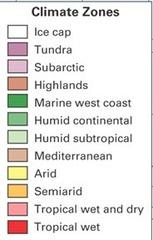
Meteorology HW
Quiz by Vivian Bridges
Feel free to use or edit a copy
includes Teacher and Student dashboards
Measure skillsfrom any curriculum
Measure skills
from any curriculum
Tag the questions with any skills you have. Your dashboard will track each student's mastery of each skill.
With a free account, teachers can
- edit the questions
- save a copy for later
- start a class game
- automatically assign follow-up activities based on students’ scores
- assign as homework
- share a link with colleagues
- print as a bubble sheet
94 questions
Show answers
- Q1Average weather of a particular area over a long period of time - Includes annual variations in temperatures and precipitation, which are influenced by latitude, closeness of lakes and oceans, topography, wind patterns and air masses.Users re-arrange answers into correct orderJumble30s
- Q2Warm ocean current that develops off the western coast of South America and can cause short-term climatic changes felt worldwide.Users re-arrange answers into correct orderJumble30s
- Q3Amount of water vapor in the airUsers re-arrange answers into correct orderJumble30s
- Q4Divides climates into five basic types, based on the mean monthly values of temperature and precipitation and types of vegetation.Users re-arrange answers into correct orderJumble30s
- Q5Cloud formation that occurs when warm moist air is forced to rise up the side of a mountain.Users re-arrange answers into correct orderJumble30s
- Q6Layer of the stratosphere with a high concentration of ozone; absorbs most of the Sun's harmful ultraviolet radiationUsers re-arrange answers into correct orderJumble30s
- Q7Energy transfer through space by visible light, ultraviolet radiation, and other forms of electromagnetic waves.Users re-arrange answers into correct orderJumble30s
- Q8Increase in temperature with height in an atmospheric level, which inverts the temperature-altitude relationship and can worsen air-pollution problems.Users re-arrange answers into correct orderJumble30s
- Q9Large body of air that takes on the characteristics of the area over which it forms; can be described by its stability, temperature, and humidity.Users re-arrange answers into correct orderJumble30s
- Q10Deflects moving particles, such as air, to the right above the equator and to the left below the equator; caused by the Earth's rotation and combines with the heat imbalance found on Earth to create the trade winds, polar easterlies, and prevailing westerlies.Users re-arrange answers into correct orderJumble30s
- Q11Change in the wave frequency that occurs in energy when that energy moves toward or away from an observer.Users re-arrange answers into correct orderJumble30s
- Q12Boundary between two air masses of differing densities; can be cold, warm, stationary, or occluded and can stretch over large areas of Earth's surface.Users re-arrange answers into correct orderJumble30s
- Q13Branch of Earth science that studies the air that surrounds our planet - includes the study of atmospheric phenomena such as fog, clouds, snow, rain and lightning.Users re-arrange answers into correct orderJumble30s
- Q14Extremely powerful, self-sustaining thunderstorm characterized by intense, rotating updrafts.Users re-arrange answers into correct orderJumble30s
- Q15Violent, whirling column of air in contact with the ground that forms when wind direction and speed suddenly change with height, is often associated with a supercell, and can be extremely damaging.Users re-arrange answers into correct orderJumble30s
